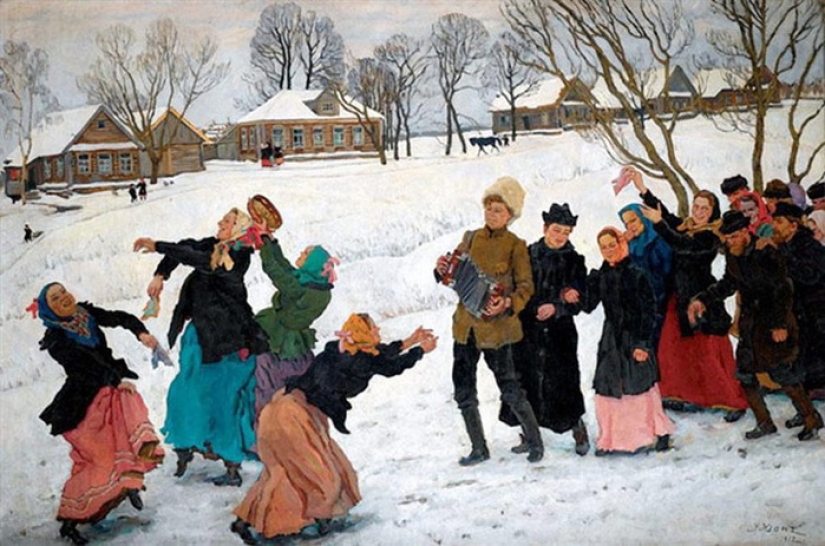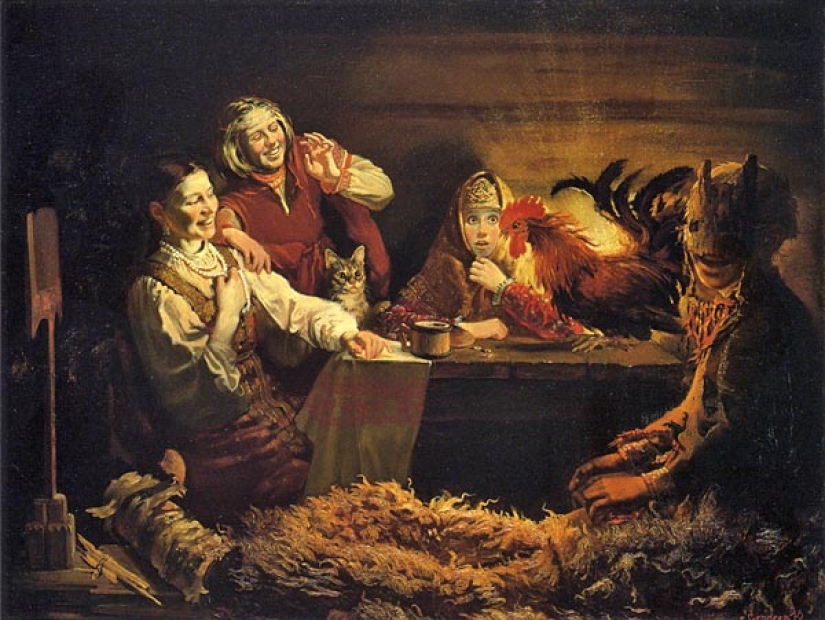The tradition of celebrating the old New Year among the Slavs originated back in 1918, when Soviet Russia was forced to switch to life according to the Gregorian calendar in order to eliminate the frightening time difference between Europe and Russia. Subsequently, the Julian calendar was abolished, but the Orthodox Church did not obey the order of the Soviet government and continued to celebrate the holiday in the old regime, but now on January 14. That is, the old New Year is a New Year that people continue to celebrate in the old style.
(6 photos in total)
 Source: ysia.ru
Source: ysia.ru

On the night of January 13-14, the people repeatedly celebrated the arrival of the New Year, the eve of which was called Vasiliev Evening in honor of the patron saint of pig breeders Basil the Saint. On this day, a pig was usually slaughtered, from the meat of which countless hearty dishes were prepared, since it was the pig that served as a symbol of livestock fertility and family well-being among the ancestors. In addition to the above-mentioned name, this day was often called by the people as "Generous Evening" or "Ovsen".

In the morning, the housewives treated the whole family to wheat porridge, which was generously seasoned with meat or honey. There was a sign among the people: the tastier the porridge, the better the coming year will be. But if the dish failed, then the family will be haunted by failures. Then, from lunch until evening, the women baked pancakes, made dumplings with different fillings and baked piglets. The men helped them with the housework, and the children went caroling.

The ceremony of "bunting" was accompanied by dressing up in national costumes and walking from house to house with songs that were supposed to attract good luck and prosperity to the village. The owners, who let them caroling on their doorstep, necessarily treated the children to something delicious. In the evening, a generous table was set to appease the coming year, and at night the whole family went to visit neighbors to attract peace and grace into the relationship.
On the morning of January 14, young people took to the streets and lit bonfires to burn down the "didukh" and jump over the New Year's fire as a sign of purification. On this night, they believed that the more stars there were in the sky, the more the harvest would be ruined.

In order for the festive table to comply with the canons of Old Slavonic traditions, it is important to serve kutya to the table on the Old New Year's holiday, which is prepared from buckwheat and barley (peeled rice is used today) with the addition of a variety of dried fruits, nuts, grapes and honey. The richer the filling, the better. The thing is that each product has a sacred meaning: nuts symbolize health, raisins — longevity, grain — the beginning of a new life, honey — good news, poppy seeds — prosperity.
By the way, our ancestors also paid special attention to the rituals associated with fortune telling. The main tradition in every family was eating special dumplings with a surprise. A variety of objects were hidden in their stuffing — from a bay leaf to a coin. Did you get a cherry dumpling? To temptation. With cabbage? To the money. The ring spoke of an imminent wedding, the thread warned of a long journey, the button — for a new thing, pepper and salt — for grief.

Not only the peasants were engaged in festivities at the festive table. Everyone, from young to old, waited with special reverence for the onset of darkness to do fortune-telling. People believed that the night from the 13th to the 14th is magical, it is during this period that dark and light forces descend to the earth that possess knowledge.
Popular fortune telling in the old New Year

If you want to find out what year is ahead, then you just need to listen to someone else's conversation. Ask yourself a question and listen to what people around you are saying: laughing — everything will be fine, crying or swearing — it means that you will have a hard time, and if they drink — stay away from temptations.
Divination "Prophetic line" In the old days, girls especially loved to guess at books. They prepared questions in their minds, and then called the page number and line. The answer served as a prophecy.
Divination "Green sprout" To find out who will be the first to get married, unmarried girls chose an onion for themselves and put the root in the water. Who had a sprout before, she will be the first to get married.
Fortune-telling "Stranger" To find out the name of the betrothed, unmarried girls often ran out of the house right after midnight to look for the first male they met. There was a belief: what name a stranger would call, this would be the future husband.
Fortune—telling "A bag with a surprise" In the house, a bag with a variety of small objects was prepared in advance - pebbles, cereals, handkerchiefs. There was also a crust of bread, a ring and a hook hidden there. Without looking inside, it was necessary to get the first thing out of the bag. If a girl pulled out a loaf of bread, she would live in wealth, a hook — to wait for trouble or a hard fate, and a ring — to a happy marriage.
Keywords: Fortune telling | Customs | Old New year | Traditions
Recent articles

See what uninhibited ladies looked like at the height of the American baby boom. In those days, there was no trace of silicone, and ...

We offer you a selection of interesting facts from a variety of fields of knowledge. How does our body react to sneezing? Where did ...
Related articles

What kind of wedding traditions do not happen! The Scots pour dirty slush over the bride, some peoples of India have decided to get ...

In different countries, kissing is treated differently. Somewhere no one will pay attention to the kissing couple, and somewhere ...

You would think that in today's world there is no place to wild customs? Sorry, you're wrong: the life of the pygmies of the Congo ...

Imagine a forest where hundreds of pine trees seem to bow to an invisible force and remain frozen in this strange obeisance ...